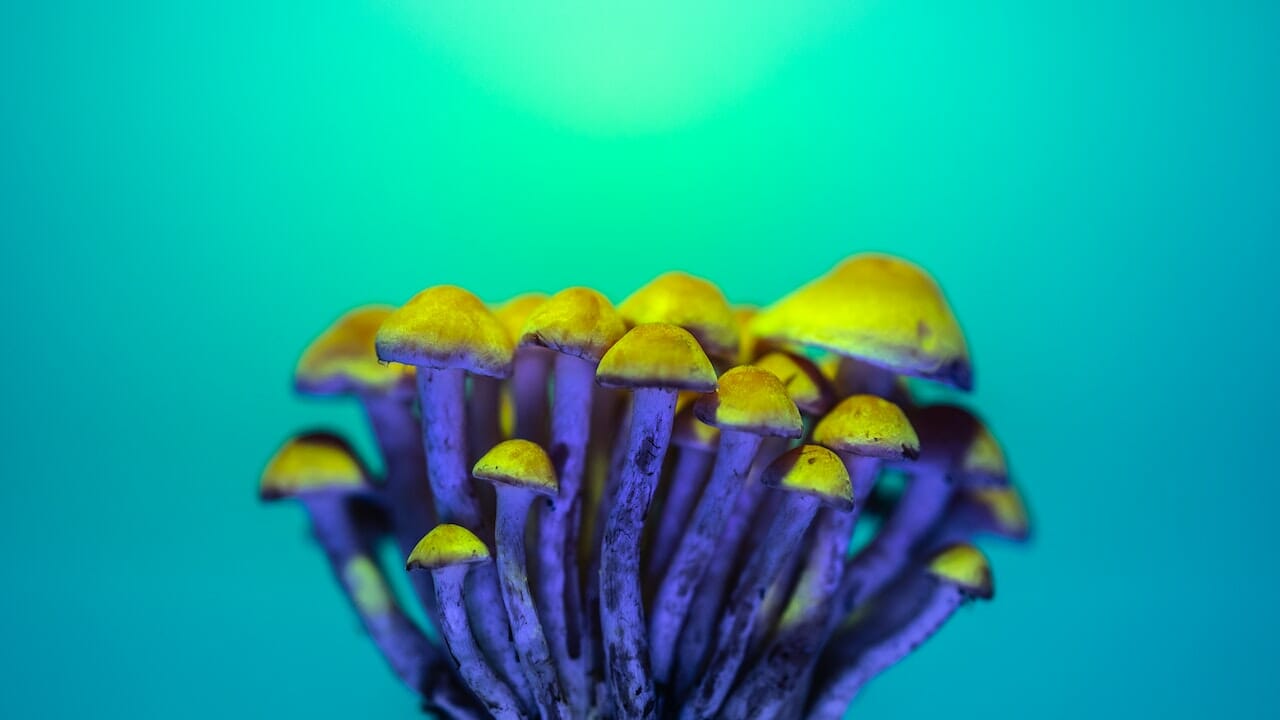Lysergic Acid Diethylamide (LSD) is an extremely potent hallucinogen that has been thoroughly researched as a psychedelic substance. Initially, LSD was primarily used for recreational purposes. However, it has now evolved into a psychoactive compound that potentially holds mental health benefits. This change in perception has led to the exploration of more user-friendly forms of LSD, such as LSD edibles.
Key Takeaways:
- LSD is a powerful hallucinogen that originates from the ergot fungus.
- Similar to psilocybin, LSD interacts with the 5-HT2A receptors.
- LSD is known to induce visual alterations, mood changes, ego dissolution, and pseudo-hallucinations.

Demystifying LSD
LSD is an extremely powerful hallucinogen that can significantly alter one’s perception of reality and greatly distort the senses. LSD originates from “ergot,” a fungus that grows on rye and other grains.
At its molecular level, LSD is a complex chemical belonging to the ergoline family. It consists of a bicyclic hexahydroindole group and a bicyclic quinoline group (lysergic acid). The term ‘Lysergic Acid Diethylamide’ is derived from the functional group attached to its core. LSD’s structure is akin to other ergoline alkaloids, such as ergotamine found in the ergot fungus Claviceps purpurea, and the neurotransmitter serotonin.
LSD’s Effects
Upon consumption, LSD travels to the brain and induces chemical reactions that can persist for several hours. The immediate effects of LSD may include:
- Unforeseeable mood fluctuations
- Distorted perception
- Dizziness
- Decreased appetite
- Difficulty in movement control
The Benefits of LSD
What are the Benefits of LSD?
The benefits of LSD are diverse and largely dependent on the dosage taken. Most scientific studies focus on the positive effects associated with low-dose consumption of this psychedelic substance. In this article, we will explore these benefits in more detail.
Pain Relief and Neuronal Development
Researchers at Maastricht University have discovered that a single microdose of LSD can provide pain relief for up to five hours or more.
In a Cold Pressor Test, where participants immerse their hands in 3°C (37.4°F) water for as long as they can bear, individuals who had taken 20 mg of LSD were able to keep their hands in the water 20% longer than those who hadn’t. They also reported feeling less pain and discomfort during the test.
Furthermore, LSD can aid in the growth and development of the brain’s 86 billion neurons. Moderate LSD doses, ranging from 5 to 20 ug, increase BDNF levels in the blood plasma. This is noteworthy as mood disorders like depression, often associated with neuroplasticity issues, may improve due to LSD’s positive impact on neuronal health.
Improving Mental Health
Dr. Robin Carhart-Harris from Imperial College London formulated the entropic brain hypothesis. This theory posits that mental health disorders stem from rigid thinking patterns sustained by an excessively active default mode network (DMN). Psychedelics like LSD have the potential to disrupt the DMN, increase brain entropy, and help dismantle negative neural pathways while fostering the development of positive ones.
A study involving over 1,000 individuals who microdose showed a decrease in depressive symptoms. Another large-scale study showed a reduction in negative moods and harmful attitudes, and an increase in open-mindedness and cognitive function.
Addiction Treatment
A meta-analysis of randomized controlled clinical trials using LSD in psychiatry demonstrated its effectiveness in treating alcohol dependence. This is further corroborated by the successful results reported by many patients treated for alcoholism by Humphrey Osmond and at the Spring Grove Hospital Centre in the 1950s and 1960s.
Easing End-of-Life Anxiety and Depression
Research conducted by Dr. Peter Gasser indicates that LSD-assisted psychotherapy may provide relief from anxiety associated with end-of-life concerns in terminally ill cancer patients. Additionally, it can improve their subjective life quality. Currently, a Phase 2 trial is underway to determine the potential effects of LSD therapy on depression.
Exploring LSD Edibles: Composition and Manufacturing Methods
LSD edibles are food and beverage items infused with the hallucinogenic substance, LSD. They come in a variety of forms, including chocolates, candies, baked goods, and even unique items such as LSD-infused mints.
Components Inside
- LSD: This is the active ingredient that produces hallucinogenic effects. It’s carefully measured and incorporated into the edible.
- Edible Base: The LSD is usually dissolved or infused into a consumable medium such as a gummy, candy, sugar cube, or other edible substances. These mediums act as the delivery method for the hallucinogenic compound.
- Flavouring and Ingredients: The specific edible product may contain flavourings, sweeteners, and other ingredients to enhance taste and texture. These can include natural or synthetic flavourings, colours, and sugars, and can vary widely.
Manufacturing Process:
- LSD Synthesis: The first step involves the chemical production of LSD. This process requires an in-depth understanding of organic chemistry and access to the necessary chemicals, equipment, and a laboratory environment.
- Liquid Formulation: After the LSD is synthesized, it’s typically transformed into a liquid form by dissolving it in a solvent. This liquid becomes a concentrated LSD solution.
- Infusion: The liquid LSD is then infused into an edible medium such as gummy candies, sugar cubes, or blotter paper. The infused medium absorbs the liquid, enabling the LSD to be consumed orally.
Experiencing the Psychedelic Effects of Psychoactive Compounds in LSD Edibles
LSD produces significant visual effects. Colours may appear more vivid, objects might seem to be encircled by halos or rainbows, and shapes may transform. Whether the user’s eyes are open or closed, they may see
LSD is renowned for instigating rapid alterations in geometric patterns and colour intensity. These visual distortions, known as “pseudo-hallucinations,” are recognized by users as non-reality, merely a result of the drug’s effect.
LSD serves as a potent tool for modifying one’s perception of self and surroundings. It has the capacity to elicit a range of mental states, from clear and profound thoughts to those lacking rational coherence. Other potential impacts include altered perceptions of time, distance, and self-image. The boundary between self and external world may appear indistinct. Sensory fusion, such as visualizing music or hearing colours, is a reported experience by some users.
Suggested LSD Products
The market is flooded with LSD edibles, but it’s crucial to buy from a trustworthy dispensary. It’s important to verify that the edibles contain LSD, not other substances such as PCP, ecstasy, or ketamine.
Deadhead Chemist – LSD Infused Gummies
Deadhead Chemist supplies LSD-infused gummies, each containing 100 micrograms (ug) of LSD, in a range of flavours. A single gummy comes in each pack and could potentially aid individuals suffering from conditions like obsessive-compulsive disorder (OCD), post-traumatic stress disorder (PTSD), alcohol addiction, depression, and cluster headaches.
Deadhead Chemist – Mint Tea
Deadhead Chemist’s raspberry mint tea provides a tastier and more aromatic way to experience the effects of LSD. LSD and other psychedelics simulate the serotonin neurotransmitter, boosting the brain’s flow state.
Earthly Delights – Candy Flips
Candy flipping became a trend during the late 1980s rave scene. Adventurers and party-goers keep enjoying the astounding effects of these two remarkable substances. Users often report intense feelings of love and interconnectedness, along with stunning visual effects like enhanced colours, object transformation, and complex geometric patterns.
Concluding Remarks
Historically, LSD has been linked to transformative experiences. As the scientific understanding of this substance expands, it has grown increasingly popular, particularly with the advent of LSD-infused edibles. These flavorful delights present a fresh pathway for users.
Enjoy the safe and pleasurable exploration of LSD through controlled doses.
Mushrooms Online Canada, Canada’s leading provider of top-notch online shrooms, offers an extensive variety of LSD-based edibles and cannabis products. Navigate through our selection at your own pace, add your favorite items to your cart, and unwind at home while we handle the delivery. Our diverse range also includes psilocybin shrooms, edibles, beverages, and capsules for your convenience. For additional information, make sure to check out our LSD delivery page!
Frequently Asked Questions
What sets LSD apart from psilocybin?
| FEATURES | LSD | PSILOCYBIN |
| Origin | Semi-synthetic chemical compound | Naturally occurring in fungi |
| Available Forms | Tabs, microdots, liquid, gummies, blotter paper | Dried mushrooms, capsules, teas, chocolates |
| Potency | Highly potent, dosage in micrograms (ug) | Varies based on mushroom species and preparation |
| Onset and Duration | Quick onset (15-60 minutes), short duration (3-5 hours) | Gradual onset (30-60 minutes), moderate duration (4-6 hours) |
How can one avoid negative experiences with LSD?
- Choose Your Environment Wisely
- Set a Positive Mindset
- Start with a Low Dose
- Arrange for a Trip Guide
- Create a Tranquil Atmosphere
- Practice Deep Breathing and Grounding Techniques
- Accept and Release
How long do the effects last?
The acid’s effects typically begin to show between 30-60 minutes after ingestion. Individuals with a higher sensitivity to psychedelics may begin to experience the effects In just 15 minutes, you may start to notice the effects of LSD. The full impact, or peak of the experience, typically occurs around three hours in. During this peak, time may appear to warp and you might experience hallucinations.
Hang in there, it’s normal to feel a sense of unreality during this stage. The peak phase generally lasts between 3 to 5 hours, after which follows the offset phase that continues for an additional 3 to 5 hours.
How does LSD interact with the human body?
LSD primarily interacts with the brain’s serotonin system, binding to and stimulating the 5-HT2A receptor. This interaction sets off a chain of neurochemical and physiological reactions. The effects of LSD, which vary significantly, can be influenced by specific factors.
Are there different forms of LSD besides edibles?
Yes, LSD comes in various forms. The four primary types of LSD are blotter paper, liquid solutions, tablets/microdots, and gelatin squares.
Further Reading:





